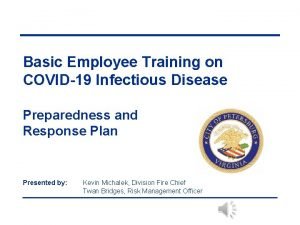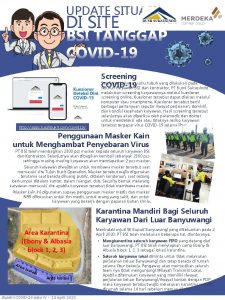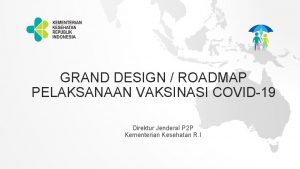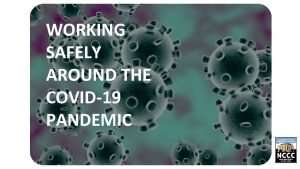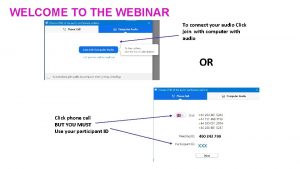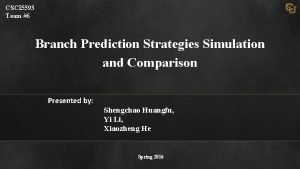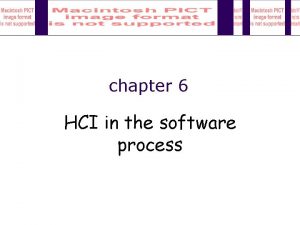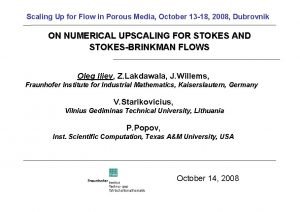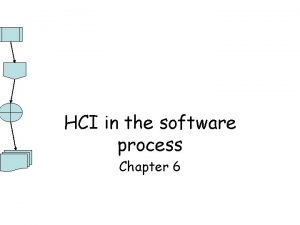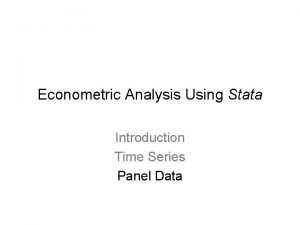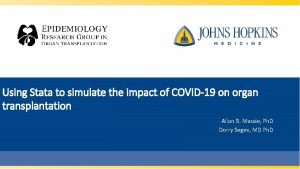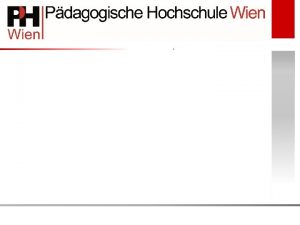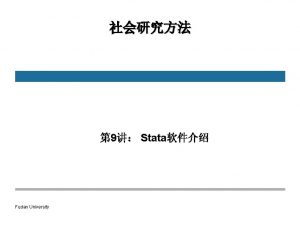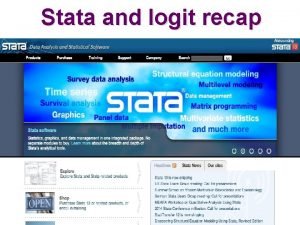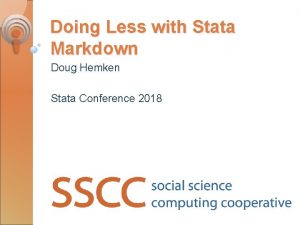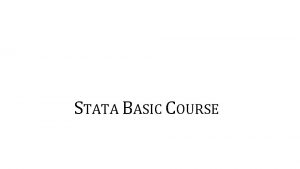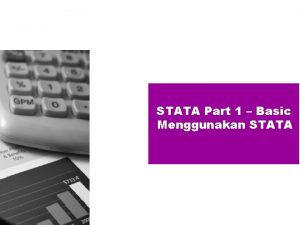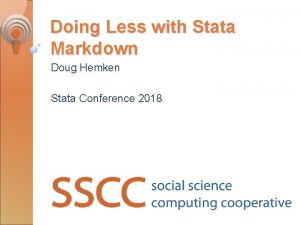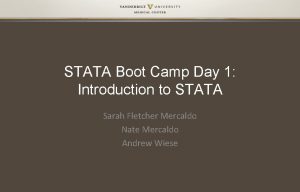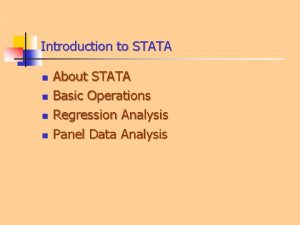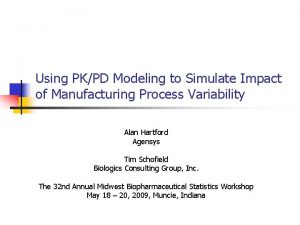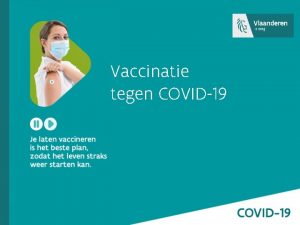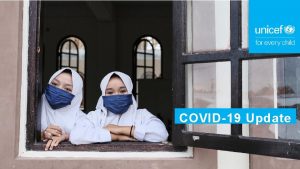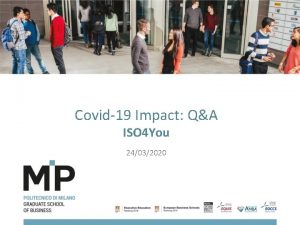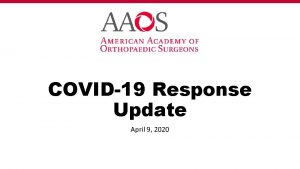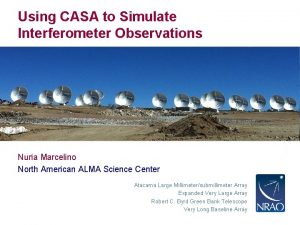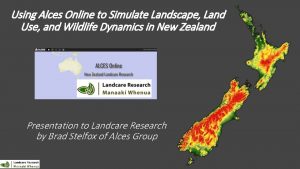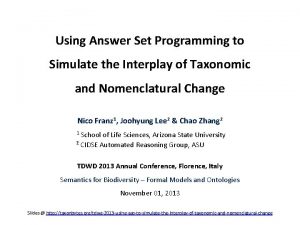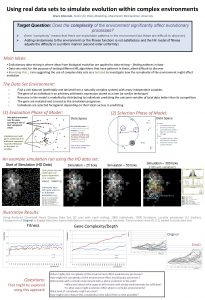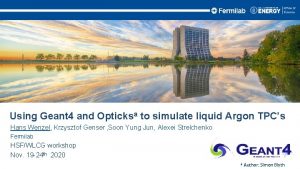Using Stata to simulate the impact of COVID19
















































- Slides: 48

Using Stata to simulate the impact of COVID-19 on organ transplantation Allan B. Massie, Ph. D Dorry Segev, MD Ph. D

Core Faculty Epidemiology Research Group in Organ Transplantation Andrew Cameron, MD Ph. D Dorry Segev, MD Ph. D, Founder and Director Professor of Surgery Nadia Chu, MPH Ph. D Instructor of Surgery Residents & Fellows Research Data Analysts Brian Boyarsky Jiyoon Ahn Zhan Shi Assistant Professor of Medicine Amber Kernodle Hannah Sung Jacqueline Garonzik-Wang, MD Ph. D Kyle Jackson Mary Grace Bowring Olivia Chen Alvin Thomas Teresa Chiang Sarah Van Pilsum Rasmussen Tanveen Ishaque Sile Yu Fatemeh Karami Yifan Yu Michael Mankowski Wanying Zhang Christine Durand, MD Director of Training and Education Assistant Professor of Surgery Martin Kosztowski Sommer Gentry, Ph. D Francisco Rivera Professor of Mathematics (USNA) Sharon Weeks Macey Henderson, JD Ph. D Heather Wasik Director of Policy and External Affairs Assistant Professor of Surgery & Nursing Allan Massie, Ph. D Director of Data and Analytics Assistant Professor of Surgery and Epidemiology Mara Mc. Adams-De. Marco, Ph. D MS Associate Professor of Epidemiology and Surgery Douglas Mogul, MD MPH Coordinators Samantha Getsin Leyla Herbst Maria (Malu) Lourdes Perez Arthur Love Assistant Professor of Pediatrics Amrita Saha Abimereki Muzaale, MD MPH Carolyn Sidoti Instructor of Surgery Lauren Nicholas, Ph. D Assistant Professor of Health, Policy and Management Tanjala Purnell, Ph. D MPH Director of Community and Stakeholder Engagement Assistant Professor of Surgery Collaborators Elisa Gordon, Ph. D MPH Bioethics, Northwestern University Jayme Locke, MD MPH Transplant Surgery, UAB Krista Lentine, MD Ph. D Nephrology, Saint Louis University Babak Orandi, MD Ph. D MSc Transplant Surgery, UAB Jennifer Motter Med/Grad Students Sunjae Bae Lucy Nam Jennifer Chen Hasina Maredia Karina Covarrubias Jessica Ruck Lindsay Dickerson Nicholas Siegal Ashton Shaffer Darius Johnson Ashley Xu Affiliates Fawaz Al Ammary, MD Ph. D Nephrology Research Assistants Gerald Brandacher, MD Full Time Dan Brennan, MD Paul Butz Michelle Krach Marie Nunez Duarte Sneha Kunwar Alexander Ferzola Shihong (Justin) Lin Morgan Johnson Eileen Rosello Anna Kinter Surgery Nephrology Errol Bush, MD Surgery Josef Coresh, MD Ph. D Epidemiology Morgan Grams, MD Ph. D Nephrology Part Time Niraj Desai, MD Surgery Tumasi Agyapong Taylor Martin Shivani Bisen Sanjana Murthy Brianna Dang Aditya Patibandla Eric Fei Jamilah Perkins Maya Flannery Prakriti Shrestha Kevin Gianaris Salma Tayel Nicole Hada Tiffany Thomas Biostatistics Esha Hase Van To Kim Steele, MD Ph. D Angela Lao Madeleine Waldram Kathryn Marks Maisy Webster Elliott Haut, MD Ph. D Surgery Lindsay Pote, Pharm. D Transplant Pharmacy Aliaksei Pustavoitau, MD Anesthesiology Daniel Scharfstein, Sc. D Surgery Ravi Vardhan, Ph. D Biostatistics Jason Wheatley, LCSW-C Transplant Social Work

Epidemiology Research Group in Organ Transplantation: data sources National registries • Scientific Registry of Transplant Recipients (SRTR) • United States Renal Data System (USRDS) Primary data collection • HOPE: HIV+ candidates and recipients • WHOLE study: living kidney donors • FAIR: frailty in transplant populations • Severe alcoholic hepatitis in liver transplant Other sources • Administrative claims • National Kidney Registry (kidney paired donation) • And more…

Transplant in a time of plague • National emergency declared March 13, 2020 • At one point in March, recorded COVID-incidence was doubling every two days • Availability of hospital resources (space/equipment/PPE), COVIDassociated surgical risk, safety of donor pool all uncertain

Clinical questions • How did the national transplant regime change in the wake of COVID -19? • Is kidney transplantation safe under COVID-19?

https: //pubmed. ncbi. nlm. nih. gov/32594606/

THE PROBLEM: a pandemic is ravaging the land.

THE PROBLEM: a pandemic is ravaging the land. THE PROBLEM: we have to quickly generate lots of tables, involving similar calculations.

THE PROBLEM: a pandemic is ravaging the land. THE PROBLEM: we have to quickly generate lots of tables, involving similar calculations. Also: some data comes from a script run on a remote server by somebody else.

Solution: 1. Generate "observed" event counts: save in a formatted text file 2. Model "expected" event counts: save counts as. dta files 3. Separate script to generate tables of observed/expected counts • Program calc_exp posts a single row of a single table to a Stata frame • Program tablesetup creates an MS-Word table using putdocx and writes headers • Program writerow writes a single formatted row to an MS-Word table • Program compare_obs_exp invokes these functions to write a single table with putdocx • The script obs_expected_tables. do calls compare_obs_exp three times to write three tables

Get_observed_counts_ki. do Write out each set of counts to a different text file

Get_observed_counts_ki. do Sample output:

Modeling expected counts Model one outcome at a time and save in a. dta

Obs_expected_tables. do Main body

Obs_expected_tables. do compare_obs_exp: prepare formatted expected counts

Obs_expected_tables. do compare_obs_exp: Create a dataset with one row per table line

Obs_expected_tables. do compare_obs_exp: write the table header

Obs_expected_tables. do compare_obs_exp: write the table header

Obs_expected_tables. do compare_obs_exp: write the table header

Obs_expected_tables. do compare_obs_exp: write the table rows

Obs_expected_tables. do Last line of the script: launch the Word doc automatically

The result

Regression tables using a similar schema

Louis-Zeger confidence intervals

Louis-Zeger confidence intervals

Key Clinical findings • New kidney waitlist registrations dropped by 18% • Deceased-donor KT dropped by 24% • Living donor KT dropped by 87% • Declines in new listings and DDKT were greater among states with more COVID-19 • Waitlist mortality increased 2. 2 -fold in states with the most COVID-19 https: //www. ncbi. nlm. nih. gov/pmc/articles/PMC 7361931/

https: //pubmed. ncbi. nlm. nih. gov/32515544/

The question With increased mortality risk due to COVID-19, is kidney transplantation still safe?

The problem In March of 2020, we didn't have good data on risk of COVID-19 incidence or mortality in transplant populations

The solution Create a simulated population, give some of them COVID-19, and analyze mortality risk

Markov decision process model Patients choose immediate KT or n-month delay

Markov decision process model They then advance through the states of the model, one month at a time, for five years

Markov decision process model Probability going to a different state is determined by simulation parameters, or models from real life

Markov decision process model See which decision (immediate vs delay) is less likely to lead to death

Epidemic parameters for simulation Epidemic parameters (Co. V acquisition/mortality risk) chosen from a range of possible values • Community Co. V acquisition risk • Additional risk on waitlist • Nosocomial risk at transplant • Waitlist case fatality rate • Post-KT CFR • Length of transplant delay

A little trick from J. Scott Long

Simulation workflow • Model waitlist mortality in the absence of COVID-19 (Poisson regression, adjust for candidate characteristics) • Model post-KT mortality in the absence of COVID-19 (also Poisson, vary by months post-KT) • Create a virtual population • Set parameters for COVID-19 risk • Model risk of mortality each month if immediate KT • Model risk of mortality each month if n-month delay

Creating the sim population • In some simulations, can be as simple as clear set obs [some big number] • For this one, we had one virtual patient for each unique combination of covariates in the actual dataset egen x_group = group(`covariates') drop `id_variables' duplicates drop isid x_group

Running the simulation Select Co. V parameters from random distributions

Running the simulation Calculate risk of mortality for each patient profile under those conditions

Running the simulation sim_iter generates expected survival at each month 1 -60 for each patient under the specific epidemic parameters

Running the simulation Saves each iteration to a different filename (to spend less time swapping/appending)

Running the simulation Saves each iteration to a different filename (to spend less time swapping/appending)

Stitch the simulation results together In a very short, separate script

Analyze the output Representative survival curves

Analyze the output Characterize the effect of varying a single parameter

Key clinical findings • Co. V acquisition parameters, case-fatality ratios, and duration of delay have the greatest effect on survival benefit/harm • KT continues to provide survival benefit under COVID-19 except under unrealistic assumptions of case fatality ratios • For KT, question of survival benefit/harm is generally independent of patient characteristics (not so for liver…)

Implications • Our work helped motivate the restart of KT at our hospital and at other centers across the country • This simulation framework can be useful outside of the context of COVID-19 (e. g. for high-risk patients or marginal donor organs)
 What do if test positive covid19
What do if test positive covid19 Http//apps.tujuhbukit.com/covid19
Http//apps.tujuhbukit.com/covid19 Vaksin covid19
Vaksin covid19 Do if you covid19
Do if you covid19 Covid19 athome rapid what know
Covid19 athome rapid what know Simulate
Simulate It simulate or animate some features of intended system.
It simulate or animate some features of intended system. Thermocouple simulator circuit
Thermocouple simulator circuit Simulate oled upscaling
Simulate oled upscaling Fluke 789 fuses
Fluke 789 fuses It simulate or animate some features of intended system.
It simulate or animate some features of intended system. Time series analysis using stata
Time series analysis using stata Cleaning data in stata
Cleaning data in stata ưu thế lai là gì
ưu thế lai là gì Thẻ vin
Thẻ vin Thơ thất ngôn tứ tuyệt đường luật
Thơ thất ngôn tứ tuyệt đường luật Cái miệng nó xinh thế chỉ nói điều hay thôi
Cái miệng nó xinh thế chỉ nói điều hay thôi Các châu lục và đại dương trên thế giới
Các châu lục và đại dương trên thế giới Bổ thể
Bổ thể Từ ngữ thể hiện lòng nhân hậu
Từ ngữ thể hiện lòng nhân hậu Diễn thế sinh thái là
Diễn thế sinh thái là Tư thế ngồi viết
Tư thế ngồi viết Giọng cùng tên là
Giọng cùng tên là Slidetodoc
Slidetodoc Phép trừ bù
Phép trừ bù Hát lên người ơi
Hát lên người ơi Khi nào hổ mẹ dạy hổ con săn mồi
Khi nào hổ mẹ dạy hổ con săn mồi đại từ thay thế
đại từ thay thế Vẽ hình chiếu vuông góc của vật thể sau
Vẽ hình chiếu vuông góc của vật thể sau Công của trọng lực
Công của trọng lực Tỉ lệ cơ thể trẻ em
Tỉ lệ cơ thể trẻ em Thế nào là mạng điện lắp đặt kiểu nổi
Thế nào là mạng điện lắp đặt kiểu nổi Dạng đột biến một nhiễm là
Dạng đột biến một nhiễm là Lời thề hippocrates
Lời thề hippocrates Vẽ hình chiếu đứng bằng cạnh của vật thể
Vẽ hình chiếu đứng bằng cạnh của vật thể Quá trình desamine hóa có thể tạo ra
Quá trình desamine hóa có thể tạo ra Phản ứng thế ankan
Phản ứng thế ankan Môn thể thao bắt đầu bằng từ đua
Môn thể thao bắt đầu bằng từ đua Sự nuôi và dạy con của hươu
Sự nuôi và dạy con của hươu điện thế nghỉ
điện thế nghỉ Biện pháp chống mỏi cơ
Biện pháp chống mỏi cơ Trời xanh đây là của chúng ta thể thơ
Trời xanh đây là của chúng ta thể thơ Chó sói
Chó sói Thiếu nhi thế giới liên hoan
Thiếu nhi thế giới liên hoan Phối cảnh
Phối cảnh Một số thể thơ truyền thống
Một số thể thơ truyền thống Các châu lục và đại dương trên thế giới
Các châu lục và đại dương trên thế giới Thế nào là hệ số cao nhất
Thế nào là hệ số cao nhất Sơ đồ cơ thể người
Sơ đồ cơ thể người
